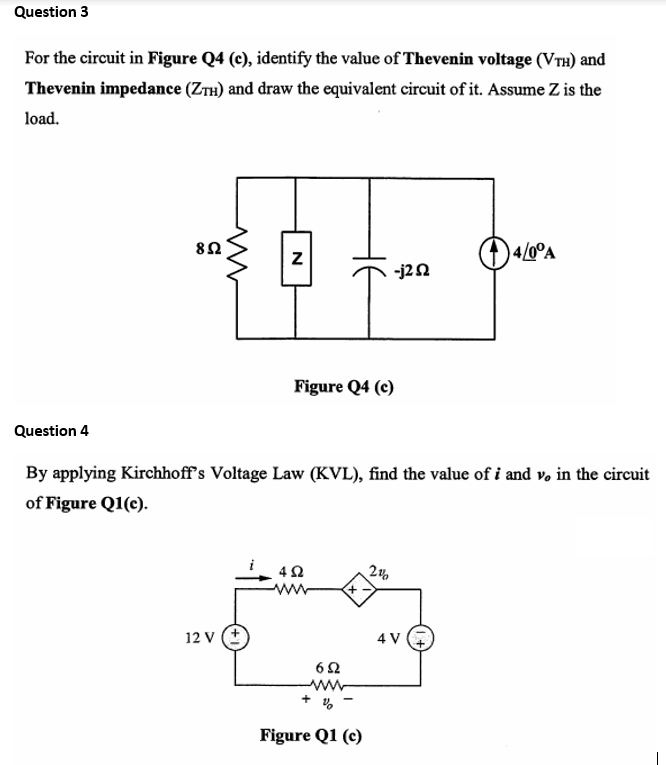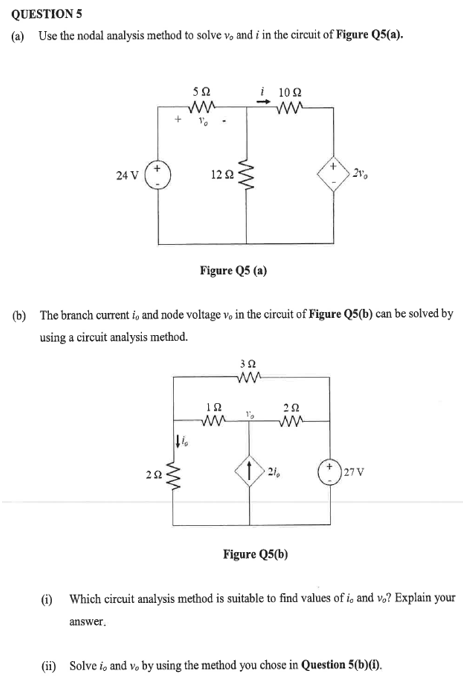For the circuit in Figure Q4 (c), identify the value of Thevenin voltage (VTH) and Thevenin impedance (ZTH) and draw the equivalent circuit of it. Assume Z is the load.
For the circuit in Figure Q4 (c), identify the value of Thevenin voltage (VTH) and Thevenin impedance (ZTH) and draw the equivalent circuit of it. Assume Z is the load.
Introductory Circuit Analysis (13th Edition)
13th Edition
ISBN:9780133923605
Author:Robert L. Boylestad
Publisher:Robert L. Boylestad
Chapter1: Introduction
Section: Chapter Questions
Problem 1P: Visit your local library (at school or home) and describe the extent to which it provides literature...
Related questions
Question

Transcribed Image Text:Question 3
For the circuit in Figure Q4 (c), identify the value of Thevenin voltage (VTH) and
Thevenin impedance (ZTH) and draw the equivalent circuit of it. Assume Z is the
load.
82
)4/0°A
-j2N
Figure Q4 (c)
Question 4
By applying Kirchhoff's Voltage Law (KVL), find the value of i and v, in the circuit
of Figure Q1(c).
ww
12 v (+
4 V +
62
ww
Figure Q1 (c)
HE

Transcribed Image Text:QUESTION 5
(a) Use the nodal analysis method to solve v, and i in the circuit of Figure QS(a).
102
ww
24 V
12Ω
Figure Q5 (a)
(b) The branch current i, and node voltage v, in the circuit of Figure Q5(b) can be solved by
using a circuit analysis method.
32
27 V
Figure Q5(b)
) Which circuit analysis method is suitable to find values of i and v.? Explain your
answer.
(ii) Solve i, and v, by using the method you chose in Question 5(b)(1).
ww
Expert Solution
This question has been solved!
Explore an expertly crafted, step-by-step solution for a thorough understanding of key concepts.
Step by step
Solved in 3 steps with 3 images

Knowledge Booster
Learn more about
Need a deep-dive on the concept behind this application? Look no further. Learn more about this topic, electrical-engineering and related others by exploring similar questions and additional content below.Recommended textbooks for you

Introductory Circuit Analysis (13th Edition)
Electrical Engineering
ISBN:
9780133923605
Author:
Robert L. Boylestad
Publisher:
PEARSON

Delmar's Standard Textbook Of Electricity
Electrical Engineering
ISBN:
9781337900348
Author:
Stephen L. Herman
Publisher:
Cengage Learning

Programmable Logic Controllers
Electrical Engineering
ISBN:
9780073373843
Author:
Frank D. Petruzella
Publisher:
McGraw-Hill Education

Introductory Circuit Analysis (13th Edition)
Electrical Engineering
ISBN:
9780133923605
Author:
Robert L. Boylestad
Publisher:
PEARSON

Delmar's Standard Textbook Of Electricity
Electrical Engineering
ISBN:
9781337900348
Author:
Stephen L. Herman
Publisher:
Cengage Learning

Programmable Logic Controllers
Electrical Engineering
ISBN:
9780073373843
Author:
Frank D. Petruzella
Publisher:
McGraw-Hill Education

Fundamentals of Electric Circuits
Electrical Engineering
ISBN:
9780078028229
Author:
Charles K Alexander, Matthew Sadiku
Publisher:
McGraw-Hill Education

Electric Circuits. (11th Edition)
Electrical Engineering
ISBN:
9780134746968
Author:
James W. Nilsson, Susan Riedel
Publisher:
PEARSON

Engineering Electromagnetics
Electrical Engineering
ISBN:
9780078028151
Author:
Hayt, William H. (william Hart), Jr, BUCK, John A.
Publisher:
Mcgraw-hill Education,